Due to maintenance, Serval will not be accessible for modification for a short time on Thursday March 24, 2022 between 7:15 a.m. and 8:15 a.m.
Thank you for your understanding.
Due to maintenance, Serval will not be accessible for modification for a short time on Thursday March 24, 2022 between 7:15 a.m. and 8:15 a.m.
Thank you for your understanding.
Due to infrastructure maintenance, Serval could experience major disruptions on Thursday March 3, 2022 between 7 a.m. and 9 a.m.
Thank you for your understanding.
Serval now periodically monitors the latest publications belonging to UNIL/CHUV published in Web of Science. When Serval finds ORCID identifiers in the metadata of the publications and that these identifiers have been linked to Unisciences by one of our authors, it adds the relevant links and sends a message to the linked persons.
The message invites authors to check their list of proposals. They will then be able to import the records into Serval in a few clicks. A video tutorial showing the steps to follow is available.
If you want to benefit from this feature, don’t forget to create your ORCID profile, to communicate it to your editor when you publish your next article and to link it to Unisciences. This will ensure that the publications are yours and reduce the likelihood of an incorrect email being sent.
You can now generate a list of publications that follows the format required by the SNSF for any new request for funds in a few clicks!
The “My SNSF report” feature allows anyone affiliated to a UNIL research unit to create a list of research results in the format requested by the Swiss National Science Foundation.
Indeed, the SNSF requires all applicants to provide a standardised set of information when applying for new funding. This includes a list of research results that can be generated from Serval and that meets the requirements of the SNSF.
You will find more information about InfoSERVAL as well as in the video tutorial that will show you how to work on your document to facilitate the layout of the publication list.
Aiming to improve SERVAL to make it more user-friendly and attractive to our researchers, we have redesigned the input interface and its workflow. Depositing your publication in SERVAL has never been easier!
The following features will therefore be pushed into production on Wednesday, November 13, 2019:
When creating a record in SERVAL, you must choose whether the publication has an identifier (DOI or PMID) or not. This allows the user to be directed to the automatic (DOI/PMID) or manual data entry.
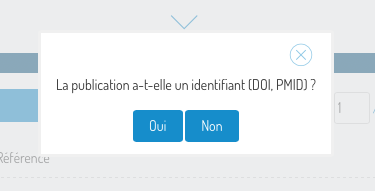
It is strongly recommended to go use the automatic entry with an ID, if you have it. This allows us to retrieve a large amount of data related to your publication without you having to enter it yourself.
Data recovery has also evolved, notably with the addition of Unpaywall (for the Open Access status of publications), thus enriching existing third-party services such as Crossref for DOIs, Pubmed for PMIDs, the UNIL service for people and the service for the UNIL structure.
All these operations may take time, but the benefit is greater than with a manual entry.
If automatic entry (DOI/PMID) is selected, the input screen is displayed:
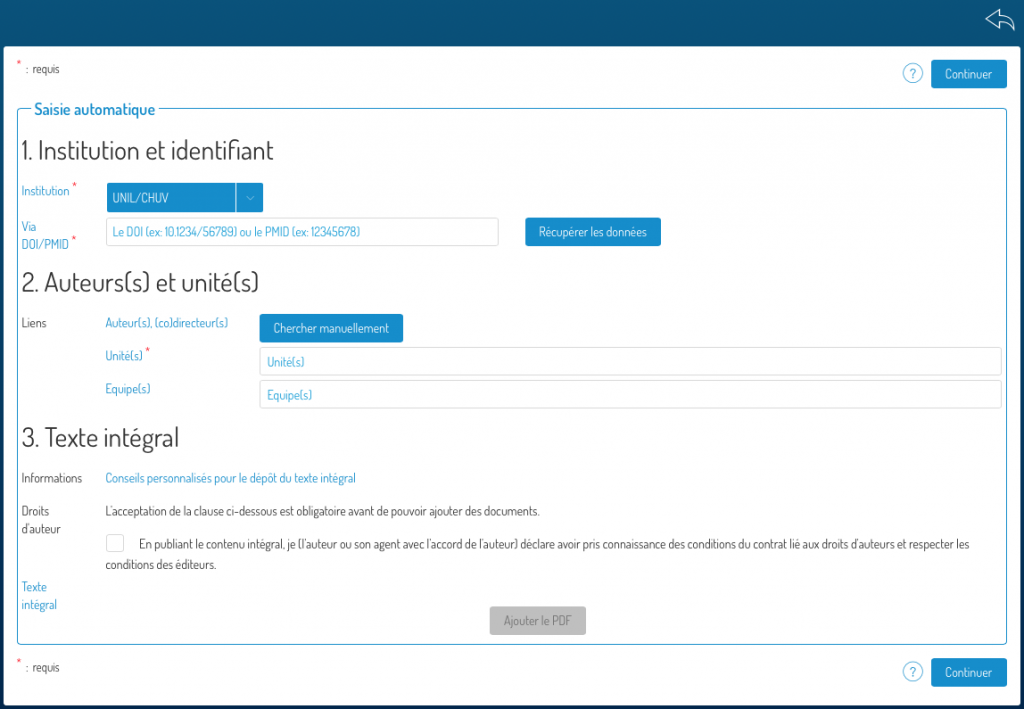
In order to enter a new publication with this method, please enter the ID and press “retrieve data”. You can then complete the rest of the form (link to people and units and PDF) and click on “continue”.
You will be redirected to a verification screen to control the data retrieved from the ID. Here you will have the choice to save the record (draft), publish it, or edit the data to complete or correct it.
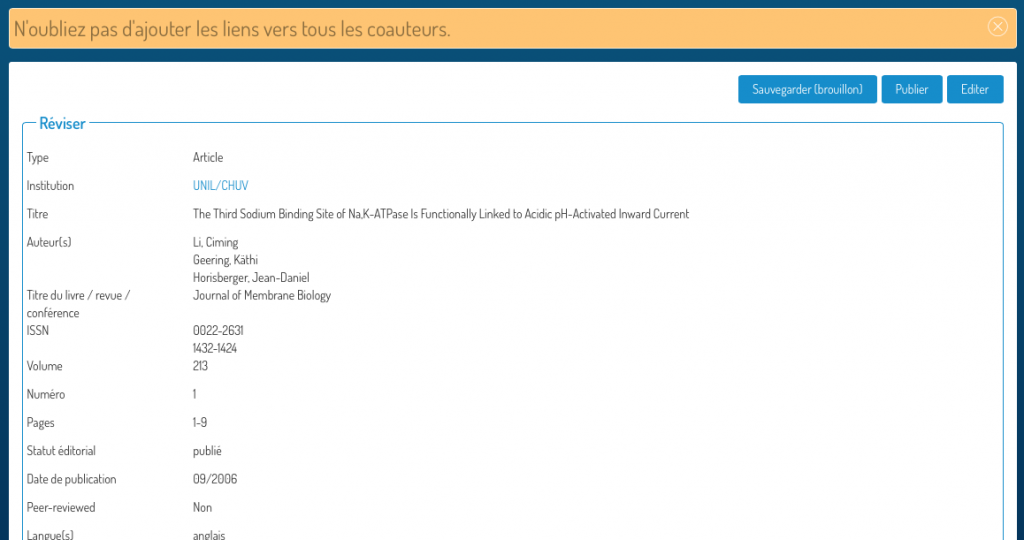
Manual entry involves the same steps, but you must enter the required metadata yourself.
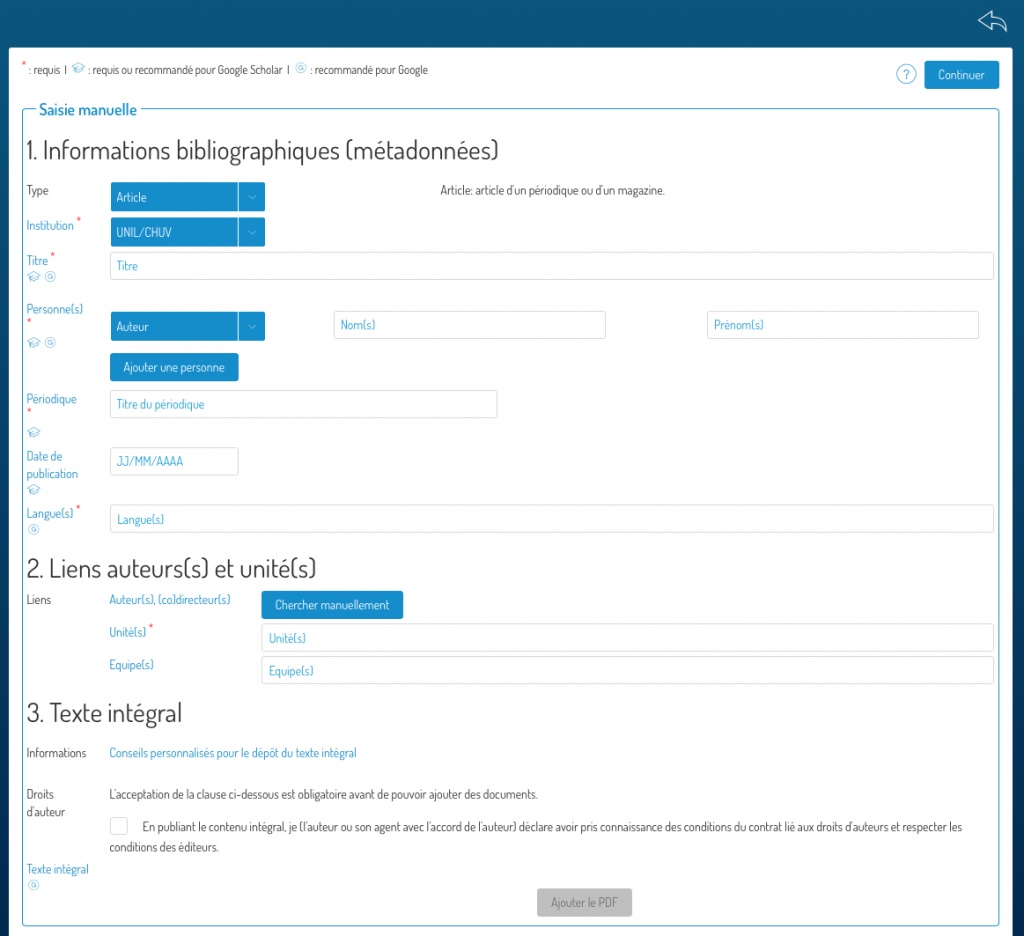
The entry of persons has also been completely reviewed:

It is now possible to enter all persons related to a publication and specify their role with the drop-down menu on the left. This makes it possible to condense the interface considerably and to have an overview of all the actors involved in the publication.
Don’t forget to link your publication to all UNIL authors and to the units where the research leading to the publication was conducted.
During automatic entry, proposed links will be displayed after data recovery from the ID. When you check the box for the authors of the publication, their unit will automatically be displayed in the “Unit” field.
If the author of the publication has not been found automatically, you can add them by using the “search manually” button.
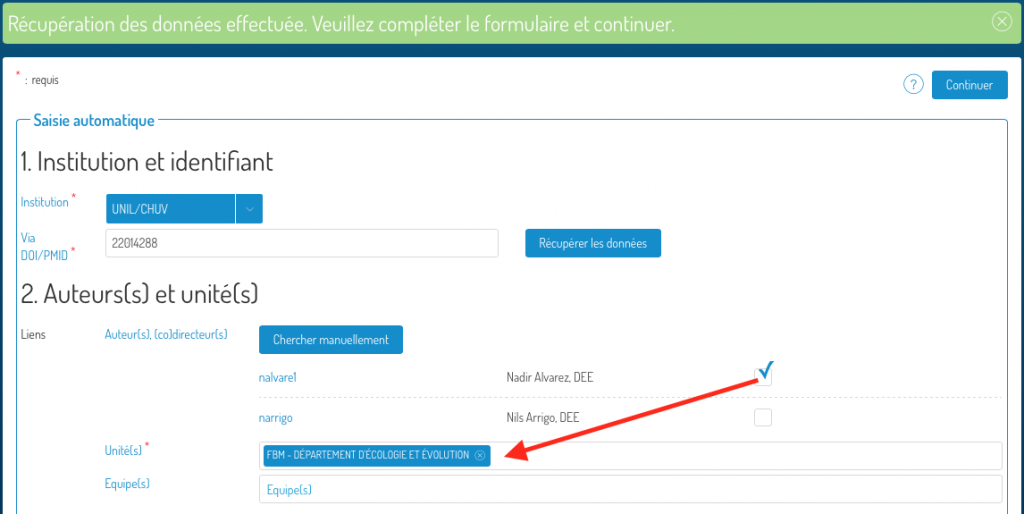
During manual entry, the proposed links are displayed after entering the full name of the authors of the publication (for those where there is a correspondence for a UNIL collaborator). As in the previous case, when you tick the box of one of the authors of the publication, their unit is automatically added in the “Unit” field.
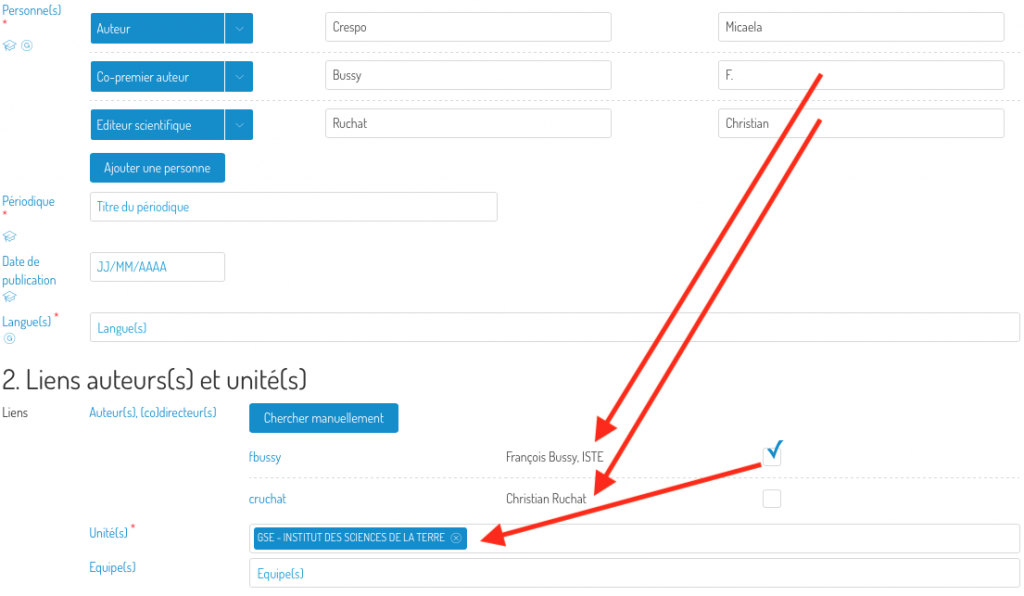
If the author of the publication has not been found automatically, you can add them by using the “search manually” button.
Advanced entry, which can be accessed by editing a record, allows automatic and manual link search. If the author of the publication has not been found automatically, you can add them by using the “search manually” button.
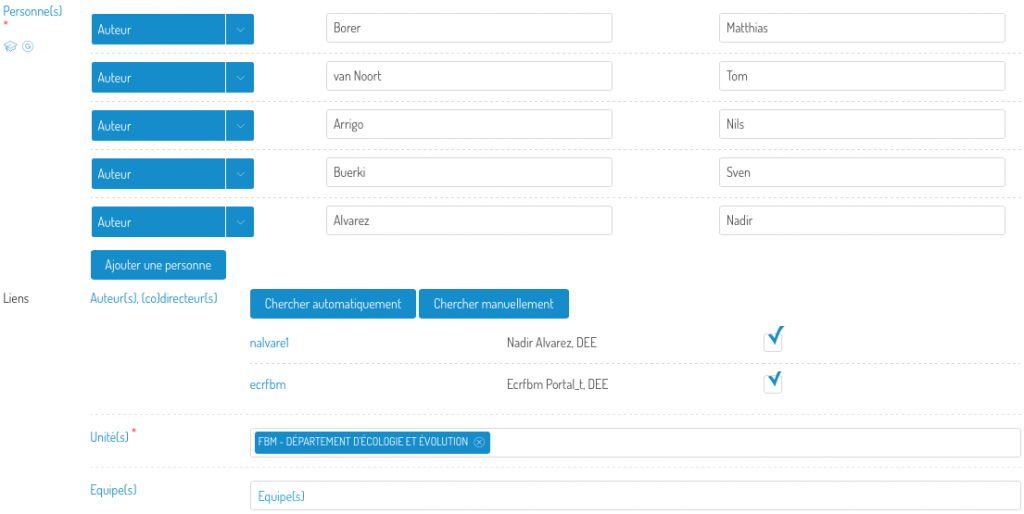
When a new document is added to a record, the default visibility is now set to “UNIL restricted”. This means that the document will only be accessible to UNIL members. Do not forget to change the visibility if you want to share it immediately (“Public”) or after an embargo period (“Under embargo”).
In order to edit an existing record (in draft or public form), press the blue chevron in the “Details/Edit” column and all available options will then be displayed.
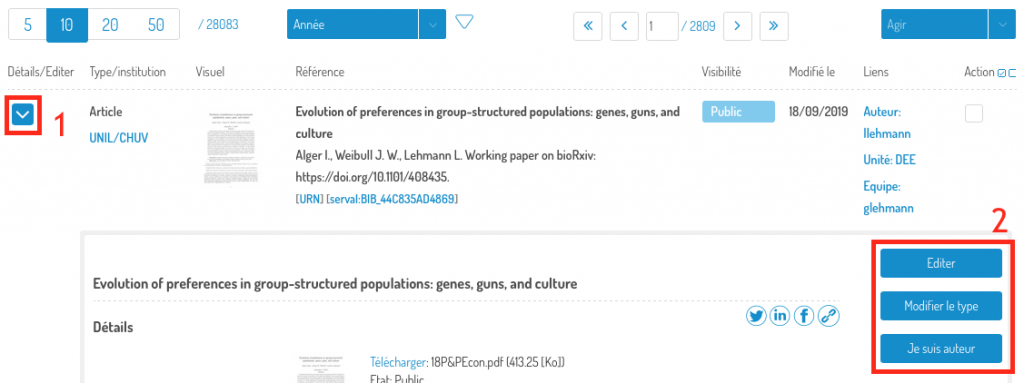
In manual entry and advanced editing of a record, some fields now have a Google Scholar and/or Google badge.
![]()
These badges indicate the fields that should be completed for your publication to be well indexed by these search engines.
The help icon is now specific to navigation. It takes you to the documentation targeted to the page you are on.

This is a text help, but it includes a link to the video tutorial.
Links to further information on self-archiving and personalized advice on depositing the full text can be found in the input section of the publication manuscript:

Weekly email notifications are sent to co-authors listing the records to which they are linked that have been created. This allows them to publish them or add the corresponding full texts.
Slides presented at scientific conferences can now be submitted and shared from SERVAL by choosing the type “inproceedings”, then subtype “slides”:

It is now possible to choose the role “scientific editor” for articles.
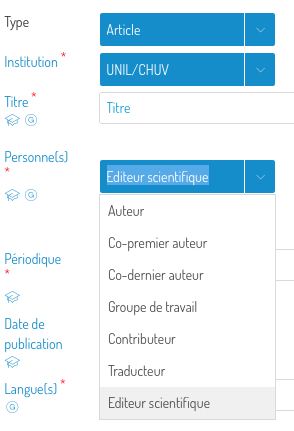
Due to an update of the repository, Serval, the courses support, the news and BiBIL will be disturbed between 7:30 and 9:00 on November 13, 2019. Only the consultation will be available in Serval (no data entry and possible modifications) during a part of the operation.
Thank you for your understanding.
Due to an important update of the repository, Serval, the course support, news and BiBIL will only be available for consultation (no data entry) from Tuesday, August 20, 2019 from 7:30 am until Thursday, August 22, 2019.
This update will bring important changes to Serval. Detailed information on this subject is available in the news August 22, 2019: Stopping validation, reducing the number of states of visibility and correction of possible notices
Thank you for your understanding.
Due to maintenance on the central infrastructure within the IT Center, Serval, course support, news and BiBIL will only be available for consultation (no data entry) on Saturday 17 August 2019 from 8:00. The entry should be possible again from 11:00.
Thank you for your understanding.
We keep striving to make SERVAL more user-friendly and attractive to our researchers. We will proceed with the introduction of (strongly requested) fundamental changes in the application as a prelude to a later simplification of the user interface.
The following features will therefore be pushed to production on Thursday, August 22, 2019:
The visibility levels of records in SERVAL are reduced to two, “draft” and “public”. The published notices (change from “draft” to “public” status) are immediately visible on UNIL websites (including Unisciences) and on SERVAL public website.

The former “personal” and “UNIL” states become “draft”, while the old “web”, “to validate” and “SERVAL” states become “public”.
Records in the “draft” state are visible to UNIL authenticated users. Authors are therefore invited to publish or delete their notices in the “draft” state.
Institutional validation is now abandoned. From now on, authors will be able to correct the records to which they are linked, knowing that they cannot be deleted once in the “public” state. They therefore have control over it and are responsible for their lists of publications.
Authors are reminded that full texts, once published, cannot be eliminated due to SERVAL’s preservation vocation and our obligations to the German National Library, which assigns permanent identifiers to our documents. However, it is possible to change the visibility of these documents to make them accessible only within UNIL (visibility: “restricted UNIL”).

Data entry agents may also enter and modify the records themselves with the agreement of the authors, but they cannot publish them. This right is reserved to authors.
Authors have the right to read and write all records belonging to them. Only authors can publish a notice. When a notice is created an automatic information message is sent to all persons linked to the notice.
Data entry officers may enter and modify records in draft or public form with the agreement of the authors. They may not publish a notice.
UNIL/CHUV theses and dissertations will be an exception to this change, due to their examination copy status, and will always require validation.
Thus, theses and dissertations currently in a “web” and “to be validated” state will be put in a “draft” state. Authors may enter a thesis/thesis, but not publish it. They will submit it for validation.

The following features will be added in production on Thursday, May 16, 2019:
Fields for entering research funds required by the plan S have been added:

The co-first and co-last author choices have been added to the list of the field “Person(s)”:
